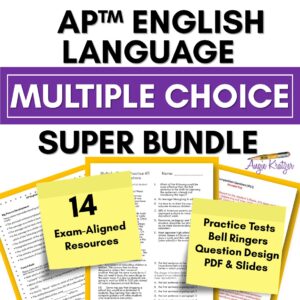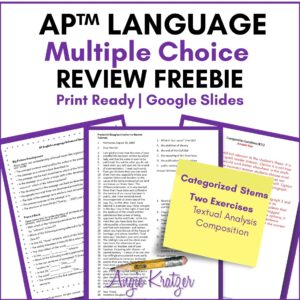“Foils bought my house.”
A friend whose husband writes standardized social studies tests said that line to me over lunch one day. Between expensive mouthfuls, she explained that anyone who is really good at writing THE foil answer choice can write his or her own ticket. Apparently, they are VERY hard to write. As we know, they are also very hard to detect.
First, some terminology:
Every multiple-choice question has three parts:
Part 1: The stem is a partial sentence or question.

Part 2: The answer is the completion of that partial sentence or proper response to the question.
Part 3: The other choices, also known as alternatives, have several labels, but their job is to test the student’s ability to pick the right one. Some test designers call these distractors, and some call them foils.
In a well-designed question, there is always ONE alternative that is THE foil, THE distractor, THE one that students are likely to get stuck on. You know which one I mean; it’s that one—the one students pick and them kick themselves over because it was their second choice but they went against their gut and picked it anyway. Yep, that one.
Cynthia Brame, Assistant Director for Vanderbilt University’s Center for Teaching, wrote this in her EXCELLENT article “Writing Good Multiple Choice Test Questions” :
“The function of the incorrect alternatives is to serve as distractors, which should be selected by students who did not achieve the learning outcome but ignored by students who did achieve the learning outcome. Alternatives that are implausible don’t serve as functional distractors and thus should not be used. Common student errors provide the best source of distractors.”
Test designers are intentionally going to use distractors that students would probably choose. These questions are field tested, after all, so we know that students DO choose these distractors. If College Board is going to put its COLLEGE CREDIT stamp on a student, it is going to make darn sure that student’s reading and composition skills are exceptional. That student can eliminate THE distractor. Don’t be too mad about that one answer choice; College Board is trying to tell colleges who is and is not already reading and writing like one of their students.
How to Eliminate the RIGHT Multiple Choice Distractor:
- Get to it quickly so you have time to think through it. On the AP Lang exam, there are five choices. Of the five, one should be relatively easy to eliminate—not ridiculously easy, buy a fairly fast elimination. Two might be synonymous, and they can’t both be the answer, so they can both go. One might be too narrow or too broad. One might be fallacious. One might be the antithesis of what the author is saying.
- Once you have eliminated the three that CAN’T possibly work, you will be left with two that COULD. I have my students mark their five answer choices with Xs and dots. They mark their three definite NOs with Xs and their two they have to choose between with dots. If one jumps out and they can choose it without doubt, they do so. If not, they don’t waste time looking again at the three crossed-out answer choices again. They only have to go back to the passage for the two they could not decide between. The student is looking for a defense for one of two, not one of five.

- Keep the test designer in mind on the final decision. He or she was thinking of a high school junior who reads like a high school junior, not a high school junior who reads like a college freshman. The designer has put in a high school junior trap door to see if the student is going to fall through it. On the composition questions, if there is an error in the answer choice, eliminate it. If the sentence is awkward on its own, it gets an X. If the choice creates another problem, X. On the reading questions, the issue is going to be a misreading. That’s why students need to shave time where they can; we want them to buy time to go back to the passage and eliminate with confidence. For example, in #4 above, I was able to eliminate B, D, and E very quickly. I put my go-back dots beside A and C, so when I went back to the passage, I was looking for patronizing or bold/forthright. Skimming back through, I saw some sarcasm, but not condescension, so I could cross out A, pick C, and move on. A high school junior might realize that condescension CAN include sarcasm and decide that where there’s smoke there fire and pick A. That’s what the question designer is aiming for.
Keep ’em coming, you say? Here are more posts with multiple choice tips for the AP Lang exam:
How to Make AP Lang Multiple Choice Less Like Torture
5 Tips for AP Lang Multiple Choice Prep
Looking for ready-to-use resources for your classroom? You might find something helpful in this bundle of all my AP Lang multiple choice resources.

How about a test run at these resources? Click through to grab this multiple choice sampler.


